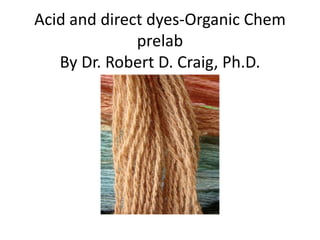Directdye snewone
•Transferir como PPTX, PDF•
4 gostaram•285 visualizações
The preparation of azo dyes is a standard reaction in the sophomore organic chemistry lab. Its adaptation to a parallel synthesis format is straightforward and the assay is trivial.Since the dyes vary widely in color, the diversity of this parallel synthesis becomes obvious. Organic topics of diazotization, electrophilic aromatic substitution and various analytical techniques enter into the discussion.
Denunciar
Compartilhar
Denunciar
Compartilhar

Mais conteúdo relacionado
Mais procurados
Mais procurados (18)
Additional slide nucleophile, electrophile, free radical

Additional slide nucleophile, electrophile, free radical
Semelhante a Directdye snewone
Semelhante a Directdye snewone (20)
Class 11 Chapter 4 Chemical Bonding and Molecular Structure.pptx

Class 11 Chapter 4 Chemical Bonding and Molecular Structure.pptx
Ion selective electrodes ISE (potentiometery) PH meter

Ion selective electrodes ISE (potentiometery) PH meter
Classification of elements & periodicity in properties

Classification of elements & periodicity in properties
LECTURE NOTE Aromatic Compound_Student_lecture 3.pdf

LECTURE NOTE Aromatic Compound_Student_lecture 3.pdf
Mais de Dr Robert Craig PhD
Mais de Dr Robert Craig PhD (20)
5Page43 how to classify stars parkslope heard from Annie.pdf

5Page43 how to classify stars parkslope heard from Annie.pdf
03 - Average Rates of Changec Cameron 1 Sara Hill.pdf

03 - Average Rates of Changec Cameron 1 Sara Hill.pdf
5.4- Measuring the Earth with Eratosthenes. Ves 2.pdf

5.4- Measuring the Earth with Eratosthenes. Ves 2.pdf
Directdye snewone
- 1. Acid and direct dyes-Organic Chem prelab By Dr. Robert D. Craig, Ph.D.
- 2. .
- 3. • . group or EWG draws An electron withdrawing electrons away from a reaction center. When this center is an electron rich carbanion or an alkoxide anion with the presence of the substituent that has a stabilizing effect. • Examples of electron withdrawing groups are • halogens (F, Cl); • nitriles CN; • carbonyls CO; • nitro groups NO2.
- 4. . • A carbanion is a nucleophile. The stability and reactivity of a carbanion is determined by several factors. These include • 1. The inductive effect. Electronegative atoms adjacent to the charge will stabilize the charge; • 2. Hybridization of the charge-bearing atom. The greater the s-character of the charge-bearing atom, the more stable the anion; • 3. The extent of conjugation of the anion. Resonance effects can stabilize the anion.
- 5. .
- 6. A carbocation (No octet rule). • A carbocation is an ion with a positively- charged carbon atom. The charged carbon atom in a carbocation is a "sextet", i.e. it has only six electrons in its outer valence shell instead of the eight valence electrons that ensures maximum stability (octet rule).
- 7. carbocations. • An electron releasing group or ERG (otherwise called electron donating groups or EDG) releases electrons into a reaction center and as such stabilizes electron deficient carbocations. • Examples of electron releasing groups are • alkyl groups; • alcohol groups; • amino groups.
- 8. .
- 9. . • a carbocation is often the target of nucleophilic attack by nucleophiles like hydroxyl (OH−) ions or halogen ions.
